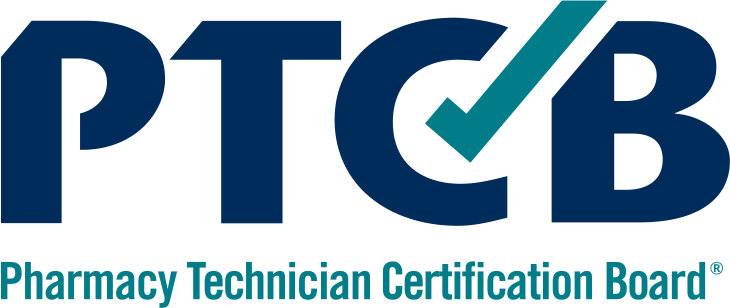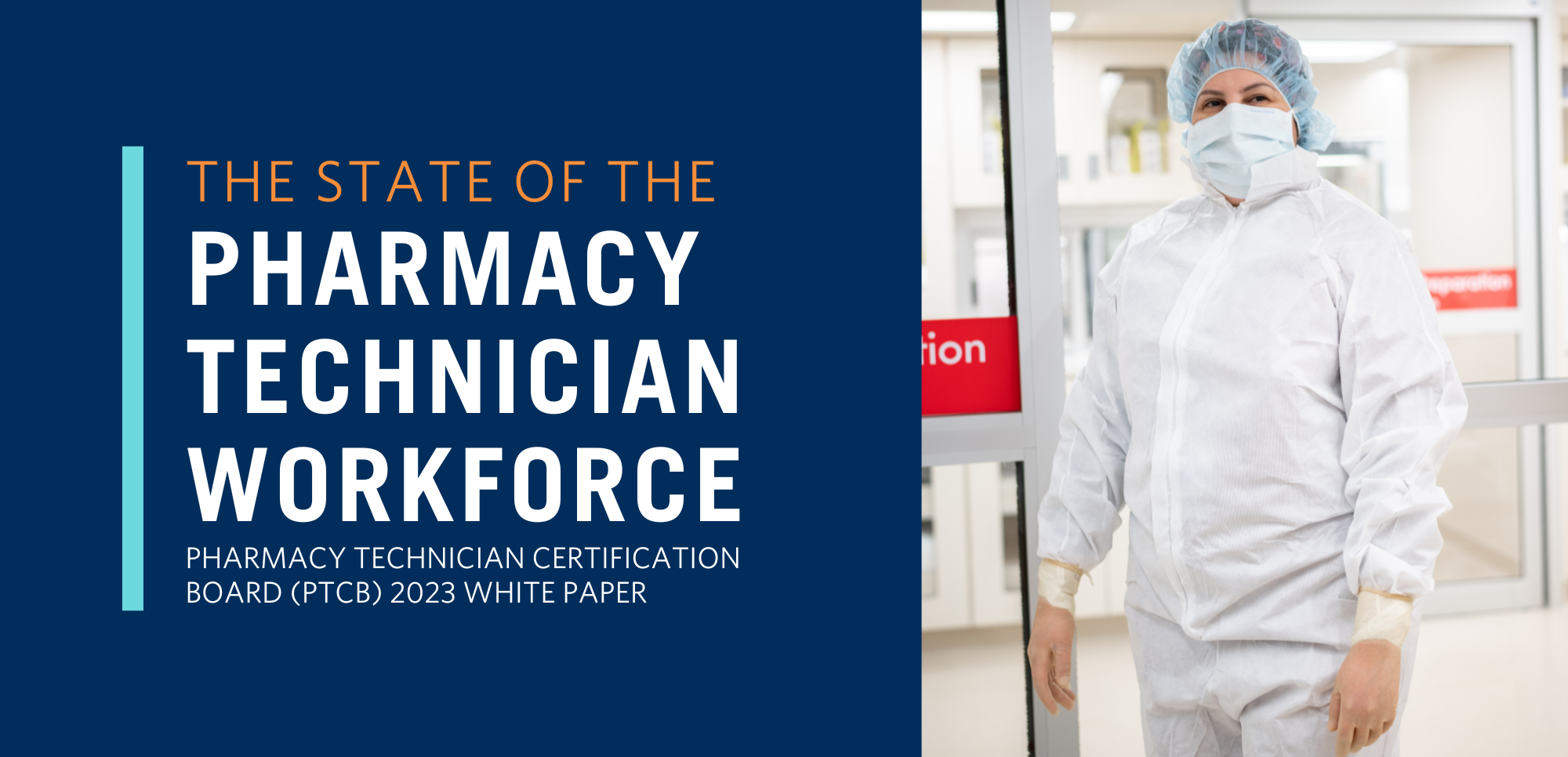
Introduction
The COVID-19 pandemic presented numerous challenges to the healthcare and pharmacy industries. Members of these workforces had to adapt to quickly changing environments to protect their patients and ensure medication safety.
Pharmacy technicians, in particular, experienced significant expansions in their responsibilities as part of their care teams. These employees became essential frontline workers and critical partners for pharmacists. These changes have helped foster the growth of the profession, further developing it as a career opportunity and not just a job.
From administering vaccinations to managing hazardous drugs, technicians now have more opportunities for growth than ever before and many have committed to making the profession their long-term career. Despite impressive levels of satisfaction with their careers, the industry continues to suffer from technician shortages.
To better understand the current pharmacy technician workforce, the Pharmacy Technician Certification Board (PTCB) fielded a survey to collect data on technicians’ attitudes toward their jobs and the actions employers could consider to retain existing talent and attract new employees.
Download the PDF VersionAbout PTCB
Until 1995, pharmacy technicians lacked a unified standard for delivering medication safety and patient care.
PTCB changed that.
Formed by a collaboration of pharmacy societies and associations across the United States, PTCB became the first certification organization for pharmacy technicians. PTCB is the only nonprofit pharmacy credentialing organization in the US, which allows it to maintain transparency. PTCB has established the national standard of excellence for those supporting patient care teams through offering the industry’s most-recognized credentials, including the PTCB credential for Certified Pharmacy Technicians (CPhTs).
PTCB set out to advance medication safety by credentialing technicians who are qualified to support pharmacists and patient care teams in all practice settings.
Since its founding more than 25 years ago, the organization has continued to update and develop credentials that reflect current best practices in patient care.
Learn MoreA Letter from the Executive Director & CEO
To continue to set the standard for credentialing pharmacy technicians and empower techs to do their jobs safely and effectively, PTCB seeks to understand the workforce that we serve.
Who are they? Why have they chosen this career? What challenges do they face? What motivates them? What support do they need to succeed?
Insights into these questions inform our knowledge about what’s needed to build technicians’ skills, strengthen their relationships with the rest of the pharmacy team, and advance the profession. Most importantly, they help us determine the best ways to recognize and support pharmacy technicians who—throughout the COVID-19 pandemic–—have taken on an increasingly critical role in supporting patient care teams and advancing medication and patient safety.
In 2022, PTCB invited more than 350,000 certified and non-certified technicians from across the country to share their perspectives in our Workforce Survey. The data generated from the more than 20,000 respondents indicate that while most technicians—particularly those who are certified—are satisfied with and committed to their careers, prolonged pandemic-related stressors led many to leave the profession.
While most of the respondents reported that they are satisfied with their careers, they identified some ways employers can improve retention. The data reflects a workforce with a strong desire to build and invest in their careers as pharmacy technicians, particularly when given the right incentives.
We know pharmacy technicians are dedicated to not just their careers but to protecting their patients. This workforce is one of the industry’s greatest assets. Investing in technicians is an investment in the future of the pharmacy.


Methodology
The data outlined in this paper was collected in May 2022 by PTCB after fielding an online survey to 366,850 pharmacy technicians, with 20,000 certified and non-certified pharmacy technician respondents. Respondents represented a statistically representative cross-section of the pharmacy technician workforce, including techs in all 50 states plus Guam, Puerto Rico, and DC, working in a variety of pharmacy practice settings.
Insights: Current State of the Profession
Occupation Satisfaction
While most technicians— particularly those who are certified—are satisfied with and committed to their careers, prolonged pandemic—related stressors led many to leave the profession. More than 25 percent noted they would have continued working as pharmacy technicians if not for the negative impacts they experienced from the pandemic.
Almost 70 percent (67.33 percent) of respondents work 30 or more hours a week. While more than 60 percent of those surveyed reported a significant increase in their workload since the start of the pandemic, nearly as many—54 percent (53.58 percent)—believe their work during the public health crisis had a much greater impact on patient care.
Workforce Geographic Distribution and Employment Settings
Forty-three percent of respondents work in urban/metropolitan areas, 36 percent work in suburban areas, and 21 percent work in rural areas.
More than half (54 percent) of respondents work in community pharmacy settings, 23 percent work in hospital/healthcare systems, and 23 percent (23.39 percent) work in other settings. Forty-one percent of respondents work in community chain pharmacies.
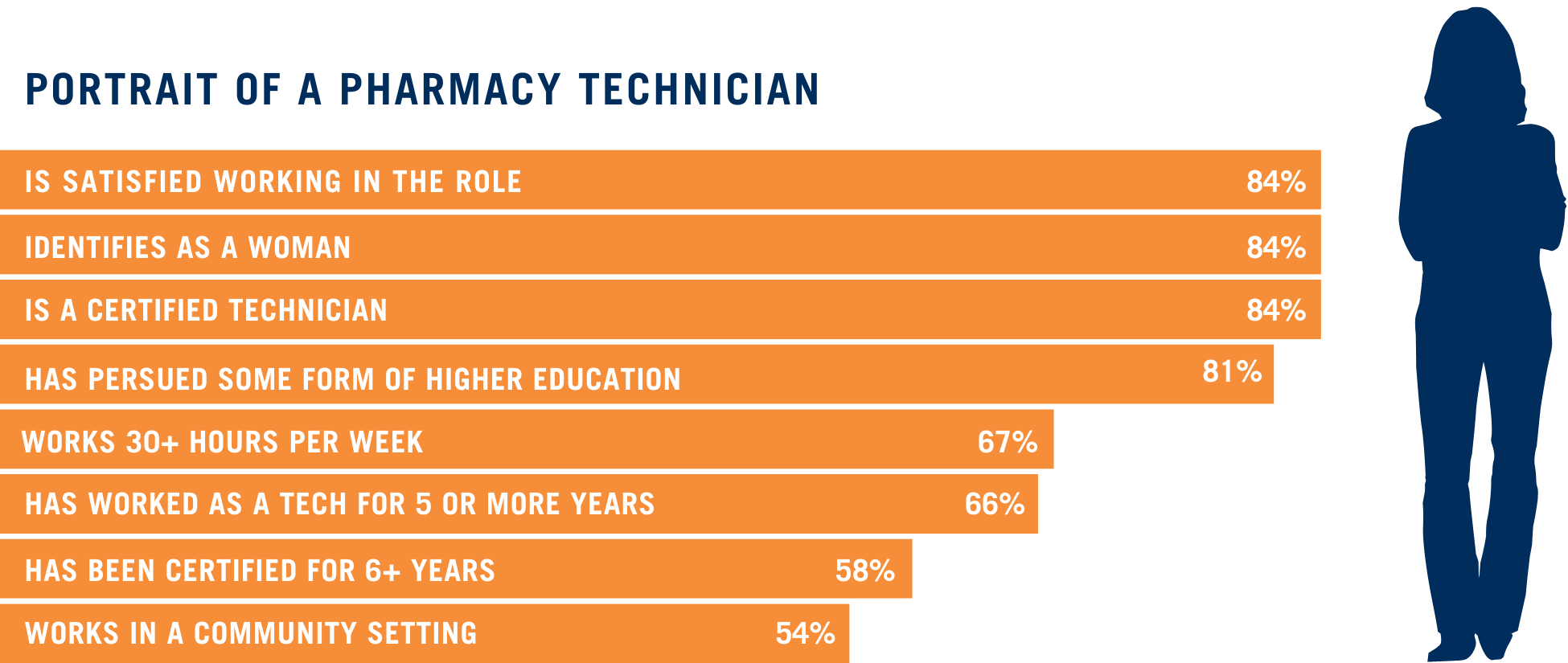
Source: PTCB’s 2022 online survey of 20,000 certified and non-certified technicians.
Insights: What Works for Technicians
Career Dedication
A majority of participants reported that a desire to help people was their primary reason for choosing their profession—a data point consistent with previous research. These pharmacy technicians said they were satisfied or very satisfied with their careers. Eighty-four percent of respondents reported being somewhat to very satisfied with their job.
Nearly 40 percent of all survey respondents have been certified for 10 years or more, an increase of almost 10 percent more than a similar PTCB national survey conducted in 2019. More than 60 percent (65 percent) of respondents received training from their employer through formal training programs and/or on-the-job experience.
Investment in Retention and Growth
Career advancement and higher wages were the top two reasons cited for pursuing certification. Sixty-three percent of respondents cited an increase in wages as the number one factor that would boost job satisfaction.
Lack of pay and/or incentives was one of the primary reasons respondents said they left the profession, along with a lack of career advancement opportunities. While COVID-19 stressors were a leading factor for technicians who decided to leave the profession, the majority of these technicians cited low pay and lack of opportunities for career advancement as significant reasons for leaving the field.
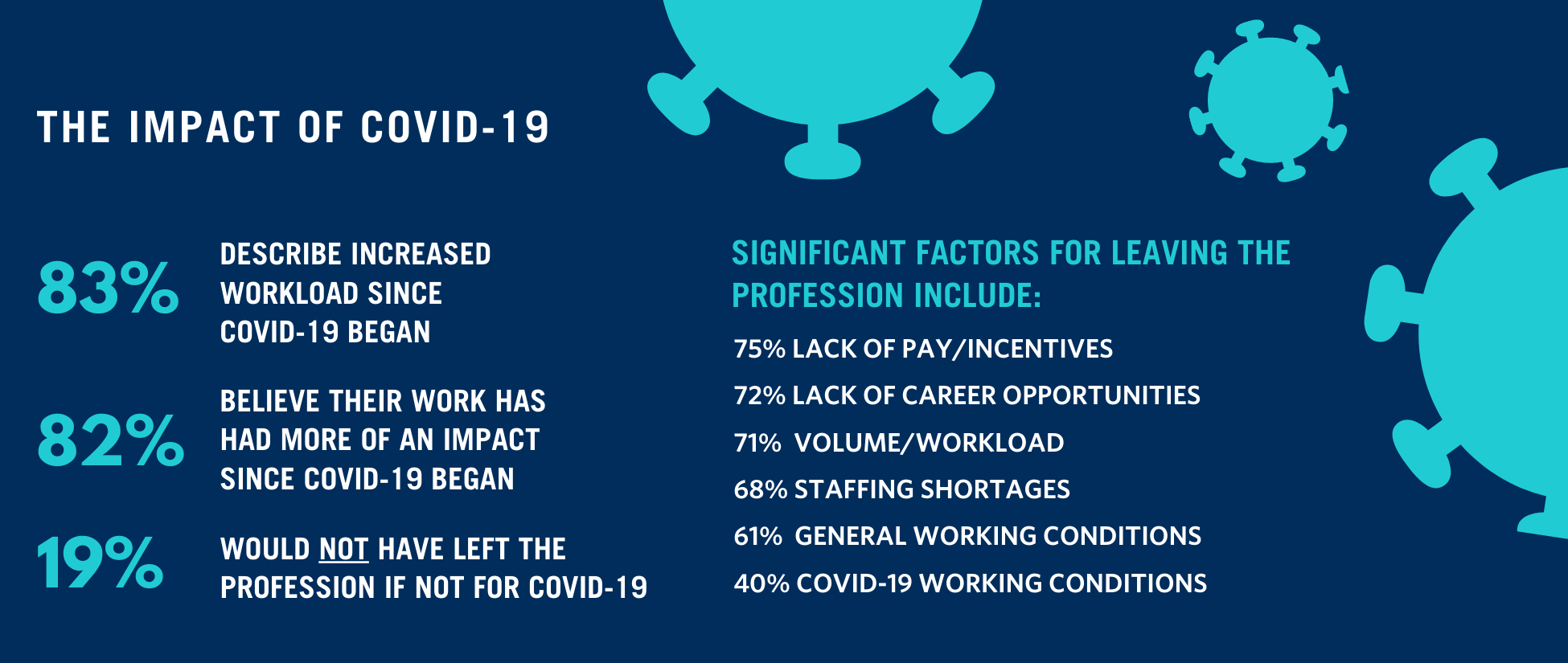
Source: PTCB’s 2022 online survey of 20,000 certified and non-certified technicians.
Insights: How Credentials Affect the Profession
Long-term Careers
Nearly sixty percent of PTCB-certified technicians consider the profession as their career—14 percent more than non-certified technicians. Half of the PTCB-certified technicians surveyed have worked in the field for at least 10 years compared to just eight percent of non-certified techs.
While certified technicians reported making higher wages than non-certified technicians, overall average hourly rates ranged from $16.57 to $24.53 depending on practice setting.
Pharmacy technicians are 14% more likely to stay in this career if they are PTCB-Certified than non-certified.
Employer Support
Nearly 90 percent of respondents have not earned specialty credentials. More than 60 percent of respondents said that their employers do not offer any incentives to maintain certification. The most commonly-cited reason for not pursuing advanced and/or specialty credentials was lack of employer recognition/incentive.
Despite high job satisfaction numbers, technicians identified several key factors that would increase their satisfaction: higher pay, more career advancement opportunities, and taking on more responsibilities. These priorities are consistent with pre-pandemic data, reflecting a workforce with a strong desire to build and invest in their careers as pharmacy technicians when given the right incentives.
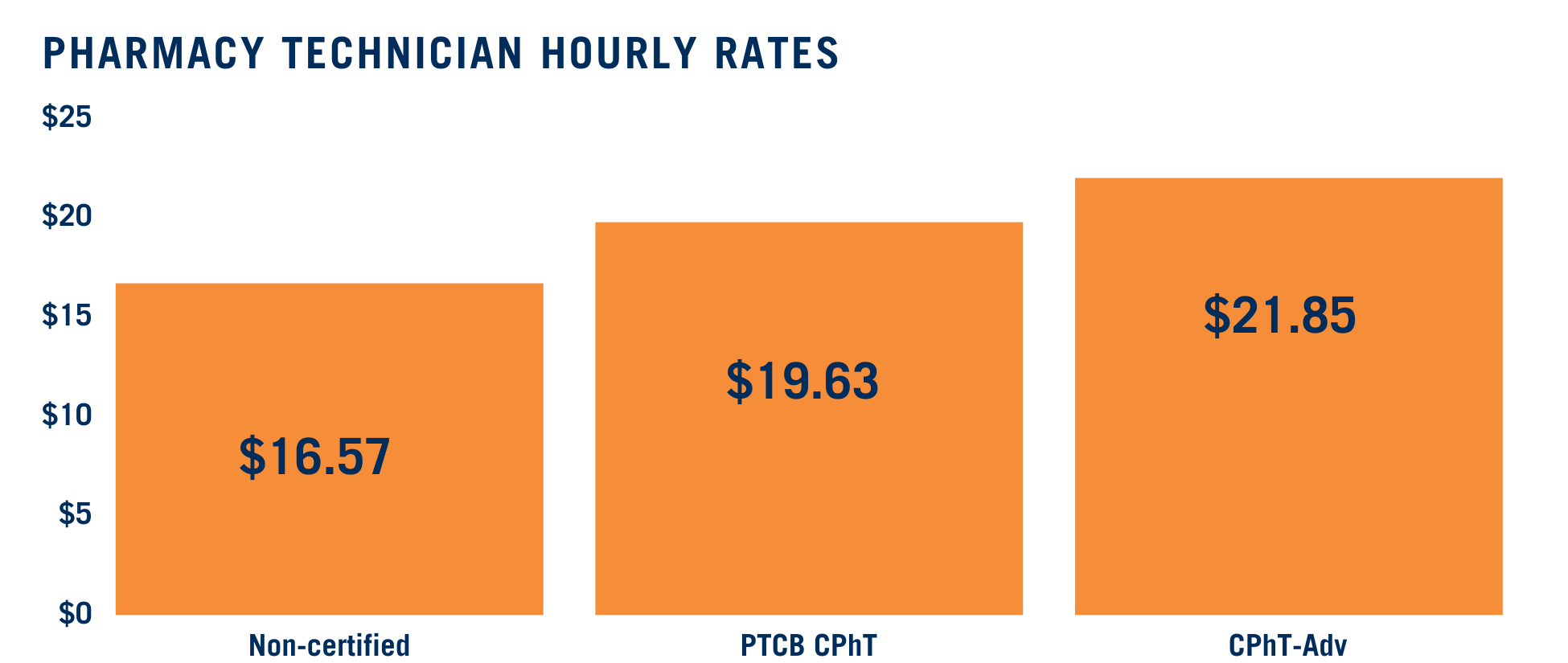
Source: PTCB’s 2022 online survey of 20,000 certified and non-certified technicians.
Conclusion
After evaluating the raw data collected from the survey, some conclusions emerged to further strengthen and develop the pharmacy technician workforce.
Technicians are dedicated and motivated but they need support—professionally and monetarily—from the larger pharmacy industry to stay in the profession. Pharmacy technicians are invested in their careers and wages need to reflect the value they add to patient safety.
It could be an expensive missed opportunity to prioritize recruiting over retention. By not addressing and directing resources to improve existing workplace challenges, employers risk higher turnover rates and indefinite cycles of recruitment. To combat staffing shortages long-term, it’s critical that pharmacies build and maintain a supportive workplace environment that rewards commitment and encourages professional growth.
According to the Michigan Pharmacists Association’s (MPA) 2021 Pharmacy Workplace Environment Task Force Report, a pharmacist’s stress levels can depend on how engaged their team is. In contrast, high levels of dissatisfaction can exacerbate the staffing shortages we currently face nationwide. And as we know, higher stress contributes to inefficiencies, which results in a stagnant workflow.
